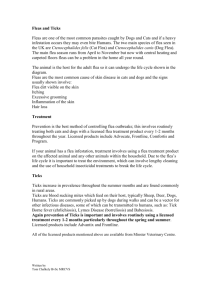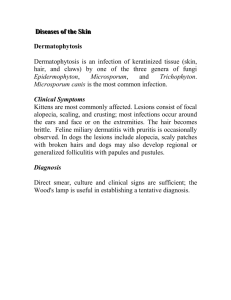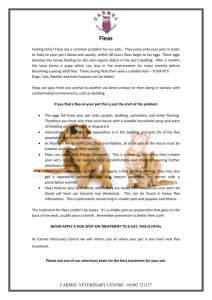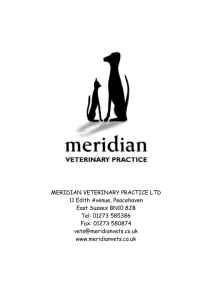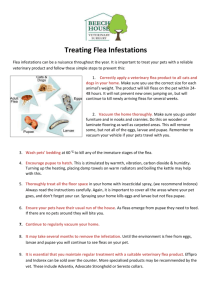Fleas_and_Flea_Allergy_Dermatitis_UCD
advertisement
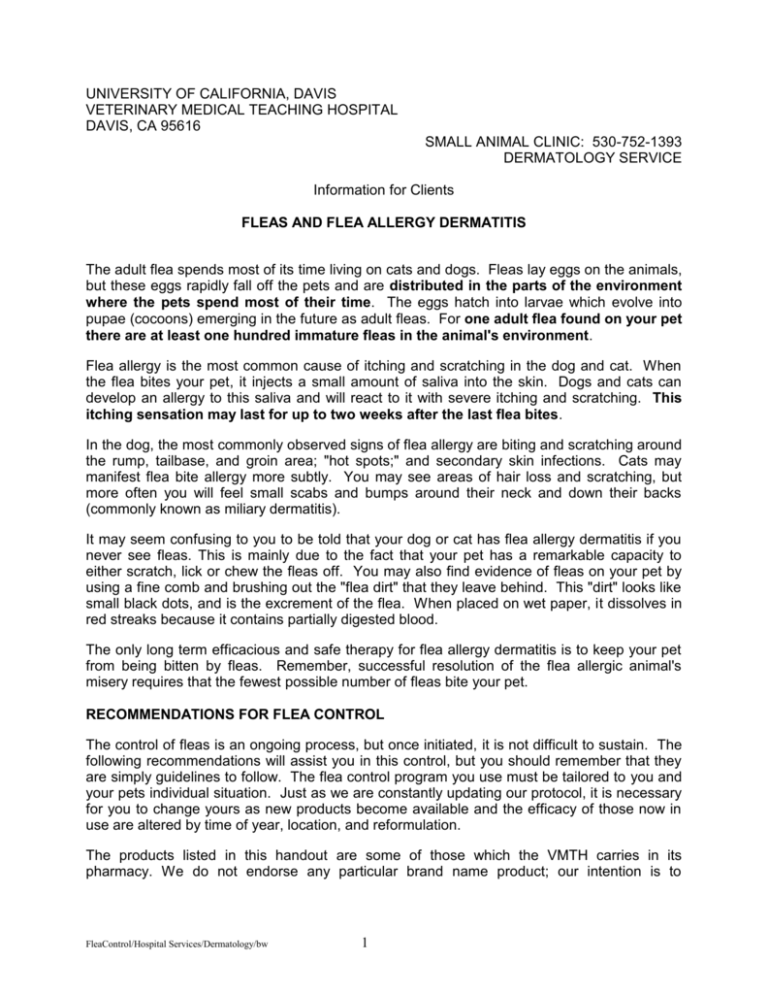
UNIVERSITY OF CALIFORNIA, DAVIS VETERINARY MEDICAL TEACHING HOSPITAL DAVIS, CA 95616 SMALL ANIMAL CLINIC: 530-752-1393 DERMATOLOGY SERVICE Information for Clients FLEAS AND FLEA ALLERGY DERMATITIS The adult flea spends most of its time living on cats and dogs. Fleas lay eggs on the animals, but these eggs rapidly fall off the pets and are distributed in the parts of the environment where the pets spend most of their time. The eggs hatch into larvae which evolve into pupae (cocoons) emerging in the future as adult fleas. For one adult flea found on your pet there are at least one hundred immature fleas in the animal's environment. Flea allergy is the most common cause of itching and scratching in the dog and cat. When the flea bites your pet, it injects a small amount of saliva into the skin. Dogs and cats can develop an allergy to this saliva and will react to it with severe itching and scratching. This itching sensation may last for up to two weeks after the last flea bites. In the dog, the most commonly observed signs of flea allergy are biting and scratching around the rump, tailbase, and groin area; "hot spots;" and secondary skin infections. Cats may manifest flea bite allergy more subtly. You may see areas of hair loss and scratching, but more often you will feel small scabs and bumps around their neck and down their backs (commonly known as miliary dermatitis). It may seem confusing to you to be told that your dog or cat has flea allergy dermatitis if you never see fleas. This is mainly due to the fact that your pet has a remarkable capacity to either scratch, lick or chew the fleas off. You may also find evidence of fleas on your pet by using a fine comb and brushing out the "flea dirt" that they leave behind. This "dirt" looks like small black dots, and is the excrement of the flea. When placed on wet paper, it dissolves in red streaks because it contains partially digested blood. The only long term efficacious and safe therapy for flea allergy dermatitis is to keep your pet from being bitten by fleas. Remember, successful resolution of the flea allergic animal's misery requires that the fewest possible number of fleas bite your pet. RECOMMENDATIONS FOR FLEA CONTROL The control of fleas is an ongoing process, but once initiated, it is not difficult to sustain. The following recommendations will assist you in this control, but you should remember that they are simply guidelines to follow. The flea control program you use must be tailored to you and your pets individual situation. Just as we are constantly updating our protocol, it is necessary for you to change yours as new products become available and the efficacy of those now in use are altered by time of year, location, and reformulation. The products listed in this handout are some of those which the VMTH carries in its pharmacy. We do not endorse any particular brand name product; our intention is to FleaControl/Hospital Services/Dermatology/bw 1 recommend a specific active ingredient for use and we use the brand name products that we stock as examples. FLEA CONTROL ON YOUR PET Dogs: (1) We recommend the use of an adulticide product (a product that kills the adult fleas) for all dogs and cats in the households. The newer veterinary “spot-on” products offer both safety and convenience. These products have been shown to be very effective when used as instructed and are not absorbed into your pet’s bloodstream (they stay in the skin) making them very safe. Advantage® (imidacloprid), Frontline Plus® (fipronil and methoprene) and K9Advantix™ (imidacloprid and permethrin) are currently available at the VMTH. Accurate dosage is based on the pet’s weight. These products are applied by parting the hair between the shoulder blades and down the back, applying the small amount of liquid directly onto the skin (not on the hair). Application frequency varies with the product and bathing needs. These products are most often applied every 2-4 weeks. It is recommended that you apply the spot-on treatment 1-2 days after bathing and avoid bathing in between applications. Depending on the product, fleas contacting your pet will die within 12-36 hours after exposure to the spot-on product. Advantage® can be safely used on puppies 7 weeks of age and older. Frontline Plus® is also effective for the brown dog tick and can safely be used on puppies older than 8 weeks. K9Advantix™ also is effective against ticks and can be used safely on puppies 7 weeks of age and older. K9Advantix™ contains permethrin which IS TOXIC FOR CATS and cats should NOT come in contact with this product. Revolution® (selamectin) and Advantage Multi® (imidacloprid and moxidectin) are “spot on” products that are absorbed into the body. Both of these products are effective against heartworms and a variety of intestinal parasites as well as fleas. Revolution® is safe to use on puppies and kittens over 6 weeks of age, Advantage Multi® is safe to use on puppies and kittens 7 weeks of age and older. Oral flea adulticides, Capstar® (nitenpyram), Comfortis™ (spinosad), NexGard™ (afoxolaner) and Bravecto™ (fluralaner) are also available. Capstar® is a very safe, short acting oral tablet which can be given daily to every other day for routine flea control, or used concurrently with other products. Capstar® is safe to use daily, or can be used as a “rescue” drug to kill fleas should they be seen on dogs and cats older then 4 weeks of age and at least 2 pounds of body weight. Capstar® begins working within minutes and kills fleas immediately after the first blood meal is taken. Comfortis™ is a chewable flavored tablet approved for use in dogs and cats, 14 weeks of age and older. Comfortis™ achieves full effectiveness within 4 hours and kills fleas after the first blood meal is taken. Comfortis™ should be administered every 2-4 weeks with a full meal. The active ingredient in Comfortis™, spinosad, is also available as a combination heartworm and intestinal parasiticide product know as Trifexis™. Trifexis™ contains milbemycin in addition to the spinosad and, like Comfortis™, should be given with a full meal. NexGard™ is a flavored chew for use in dogs and puppies 8 weeks and older. This product kills adult fleas and the American Dog tick (Dermacentor variabilis). NexGard™ should be administered once monthly. Bravecto™ is a flavored chewable tablet for dogs 6 months of age and older and 4.4# and larger. Bravecto™ begins killing fleas and ticks within two hours and achieves full effectiveness within 12 hours. Bravecto™ is administered FleaControl/Hospital Services/Dermatology/bw 2 every 3 months with food and is labeled for control of fleas and ticks (Dermacentor variabilis – American Dog Tick, Ixodes scapularis – Deer Tick, and Rhipicephalus sanguineus – Brown Dog Tick). All of these products are oral, systemic products and therefore not affected by bathing or swimming. More recently available is a flea control collar that is safe and effective for dogs and cats. The Seresto™ collar contains flumethrin and imidacloprid and is safe to use on dogs 7 weeks of age or older and cats 10 weeks of age or older. The Seresto™ collar kills fleas and ticks for up to 8 months. Three other veterinary products available for dogs are Vectra 3D™ (dinotefuran, permethrin and pyriproxyfen), Certifect™ (fipronil, methoprene and amitraz) and Parastar™ Plus (fipronil and cyphenothrin). The VMTH is not yet carrying these products, but they may currently be available through your local veterinarian or at the VMTH in the future. Vectra 3D™ is a spot-on product safe for use on dogs and puppies 7 weeks of age and older. This product kills and repels fleas, ticks and mosquitoes, and its third product, pyriproxyfen, is an insect growth regulator which prevents development of flea eggs and larva. Vectra 3D™ is recommended for monthly application. Certifect™ for dogs is another topical spot on product safe for dogs and puppies, 8 weeks of age and older. Certifect™ for dogs kills fleas and ticks and contains methoprene an insect growth regulator which prevents development of flea eggs and larva. Parastar™ Plus kills fleas and ticks on dogs and puppies 12 weeks of age and older. Certifect™ and Parastar™ Plus are also recommended for monthly application. All three of these products contain ingredients that are TOXIC TO CATS and cats should never come in contact with these products. Cats: (2) If you own cats, they must be involved in the flea control program even if they are not exhibiting any problems, or they will carry the fleas to your house, yard, and dogs. Cats are more sensitive to the chemicals in flea preparations, and many insecticides can not be used on them. For cats, we recommend using either Revolution® (selamectin), Frontline Plus® (fipronil and methoprene), Advantage® (imidacloprid), Advantage Multi® (imidacloprid and moxidectin) or Cheristin™ (spinetoram) in the feline formulation. Another product not currently available at the VMTH is Vectra™ (dinotefuran and pyriproxyfen) for cats. All these products are applied in a similar fashion as in dogs. Beginning at the base of the head, part the hair and apply the small amount of liquid to the skin (not the haircoat) along the back of the neck. Application also varies from two to four week intervals, depending on other treatments. Please follow the instructions outlined for your pet. Capstar® (nitenpyram) is also safe for use in cats as a “quick kill” in the event fleas are seen, or can be given every one to three days for routine flea control if an oral product is desirable. Juvenile Flea Stages: There are several life stages that occur before a flea becomes a biting adult. Some of these juvenile stages are also targets for flea control. Decreasing the numbers of immature (juvenile) fleas can be an excellent way to help prevent adult fleas and thus flea bites. Research has led to the release of several products that interrupt the life cycle of the flea. Often these products are used in combination to quickly and effectively decrease the flea burden of your pet. Synthetic juvenile flea growth hormone imitators are found in many flea products. Methoprene (Precor®) is contained in Frontline Plus® and Certifect™ as well as FleaControl/Hospital Services/Dermatology/bw 3 many of the indoor area treatments. Vectra 3D™ contains pyriproxyfen as one of its active ingredients. All of these synthetic hormones are very safe to use on animals and around humans. They prevent the adult female flea from laying viable eggs and prevent immature fleas from developing into adults. Program® (Lufenuron) is an oral chewable tablet available for both dogs and cats that is given monthly with food. As the adult female flea feeds on the dog or cat, the female flea lays eggs that cannot hatch and larvae that will not survive. This product is very safe, but flea-allergic animals also need protection from the biting adults. Program® is best used in combination with a topical or oral flea adulticide. Another formulation available is lufenuron in combination with milbemycin, a monthly heartworm preventative. This product, called Sentinel® is also given monthly with a full meal. Most other forms of flea control on your pet have been scientifically shown to be ineffective. Flea shampoos will only kill the adult fleas but have virtually no residual effect, and will not prevent reinfestation once they are rinsed off. Electronic flea collars, brewer's yeast, garlic, vitamin B tablets, and extracts of eucalyptus or pennyroyal, are not flea repellent, and provide no protection for your pet. Lastly, flea combs, although helpful, are similar in effect to the use of flea shampoos alone; they do not prevent reinfestation. SIGNS OF TOXICITY All flea control products are potentially toxic or may produce unexpected side effects. Toxicity may result from accidental overdose or unexpected sensitivity. Known side effects, although rare, are vomiting, diarrhea, drooling, sluggishness, weakness, or abnormal behavior. If you suspect that your animal is reacting adversely to a flea control product, stop using the product and consult your veterinarian immediately. If the reaction occurs immediately after application, the product should be rinsed off thoroughly and the animal brought to the veterinarian for evaluation. Adverse reactions may occur from minutes to days following application. Insecticides can be toxic to people; all products should be handled carefully, avoiding direct contact as much as possible. Keep all products out of the reach of children. Cats are particularly sensitive to many pesticides. ONLY USE PRODUCTS LABELED TO BE SAFELY USED ON CATS. If you have any questions about a product’s safety, please consult your veterinarian. FLEA CONTROL IN YOUR ENVIRONMENT Immature life stages of the flea accumulate in the environment when animals with fleas serve to disperse flea eggs into the environment where they then hatch into juvenile life stages. House and yard treatments need to be concentrated on "source points", which are areas where your pets spend most of their time. This typically would include the bedding and resting areas, the feeding location, etc. You can lessen the flea burden in your home by thorough vacuuming of all source points followed by disposal of the vacuum bag and by washing all animal bedding weekly in hot water and drying at high heat for twenty minutes. Steam cleaning of rugs and carpeting +/- upholstery is also helpful. In the yard, focus on areas where your pet(s) or other animals spend most of their time. Typically, fleas survive and reproduce in shaded, moist areas with plant or organic debris (under decks, bushes, storage sheds, etc). Fleas do not survive or reproduce well in sunny, FleaControl/Hospital Services/Dermatology/bw 4 open areas of lawn or patio. Elimination of yard debris will be helpful in reducing flea numbers. You may choose to utilize a professional exterminator service for the treatment of fleas in your home and garden. REALISTIC EXPECTATIONS It is important to realize that the various anti-flea medications do not eliminate the immature forms of fleas in the environment. Thus, for the first month or so you may continue to see fleas on your pet as the juvenile forms mature and search for a new host. This does not mean that the fleas have built up resistance to the medication – in reality, flea resistance to these products is quite rare. The most common reasons for failure to control a flea problem are: 1. Frequent washing of a pet treated with a spot-on product (this includes swimming in pools, lakes or the ocean). 2. Inconsistency in the application of the product. 3. Failure to treat all pets. 4. Wildlife reservoirs of fleas (feral cats, raccoons, opossums, coyotes, etc.). Thus areas below outside decks, old sheds, etc. should be barricaded or locked to discourage such ‘visitors’. FleaControl/Hospital Services/Dermatology/bw 5
